
Stuart 1639 - 1652 AD
History
The Stuart period was a turbulent time in Britan with the Scottish King James the sixth becoming James the first of Scotland and England. Then followed the Great Civil wars, the regicide of Charles the first. This led to the founding of the Commowealth under Oliver Cromwell and upon his death the restoration of the monarchy under Charles the second. His successor James the second, Englands last Catholic monarch, was deposed in the Glorious Revolution. There then followed Mary the Second and Anne, dying in 1714 and bringing to a close the Stuart period, but not their claims to power as two more revolutions followed in 1715 and 1745. Curiosley in 1642 Manchester declared for Parliament against Charles the first, but in 1745 the city rebelled and supported Bonnie Prince Charlie in the last attempt to restore a Stuart to the throne!
Death, Disease and Destruction
Death from disease apart from the wars was commonplace, with regular outbreaks of plague, typhiod, dysentry not to mention other 'fevers'. Water was almost undrinkable, pasturisation had not been invented and hygiene standards were almost non existent compared to today.
In the Wars between direct conflict, disease and other causes it is estimated that 200,000 people died. This represents a total loss of 4% of the actual population with casualities in Scotland and Ireland probably far higher. In comparison World war 2, had appx 400,000 casualties about 0.7% of the then population.
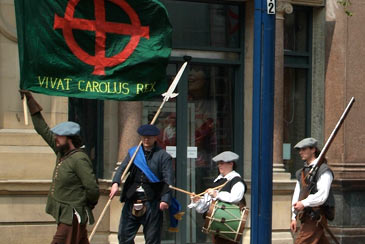
How Did the Civil War Come About?
The period of the Great Civil war runs form 1639 to 1651, covering the Bishops Wars, the Three Civil Wars, up to Charles 2nd departure for exile in France and the start of Cromwells Protectorate.
What Is the Period Famous For?
The period is usually characterised with images of stern Roundheads and dashing Cavaliers. However in reality both Armies actually were dressed and armed very similarly. Both sides had Lords, MP's and commoners, the divisions running deep, splitting families, dividing brothers, fathers, sons and mothers. Both politics and religion were dividing factors, with Parliament wanting more power and the Royalists wishing to limit Parliaments power. The Religous differences were far more complex with the Royalists broadly Catholic and Parliament representing the broad swathe of Protestantism at the time.
The North West saw a lot of the war with sieges or battles in Manchester, Liverpool, Preston, Bolton, Wigan to name but a few.
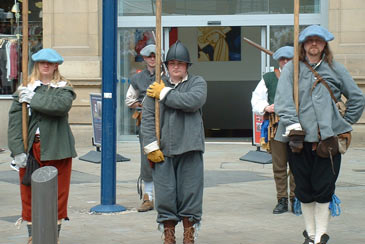
Will I Have Heard of Any Famous People From the Period?
Famous personalities to look from the period are of course the King and Cromwell, yet there are Blue Plaques in Manchester for Prince Rupert and Sir William Brereton-Didsbury Library, Site of Alport Lodge, Deansgate/ St John Street and Maj Gen Charles Worsley-Platt Hall. See if you can find any more!
Can You Give Me a Famous Quote From the Time?
Just before the Civil War began Charles I went to Parliament with 400 soldiers to arrest 5 rebel MPs - however they had already fled, and he remarked, “I see the birds have flown”.
When sitting for his portrait Oliver Cromwell ordered the painter not to flatter him but to paint him "warts and all".
Quiz Questions
- Who was the ruling monarch during the Civil Wars?
- For which side did Manchester declare, Royalist or Parliament?
- What eventually happened to the King?
You can find the answers here…
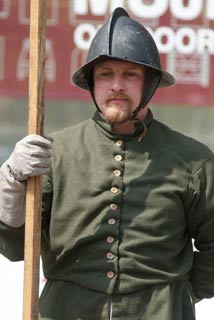 |
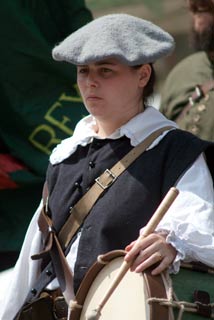 |
|
What Was the Food Like?
Soldiers rations were very basic and consisted of 1 kilo(2lbs) bread, with either a 1/2 kilo(1lb) of cheese or meat per day. There was also a provision for beer as usually the water was undrinkable! However here is something more tasty and quite easy for you to try at home;
Sausages in a pottage
1/2 kilo (1lb) good sausages
2 medium cooking appples
2 medium onions
1 cup white wine (optional)
1/2 teaspoon each of nutmeg and cinnamon
Butter for frying
Sugar to taste
- Brown the sausages in a frying pan with a little butter and remove to a saucepan.
- Peel and core the apples, cut into small chunks and brown in the same frying pan as the sausages.
- Cut the onion into rings and brown as the apple, add both to the saucepan.
- If using the wine deglaze the frying pan with 1/2 cup and add to the saucepan.
- If not add the juices from the frying pan to the saucepan.
- Add the spices and sugar to taste and cook on a low heat for one hour, serve and enjoy!
People in the 17th century preferred lots of spices compared to modern tastes.
Boiled Mutton and Lemons - Serve 16
6lb boneless lamb, cubed
1/2 cup flour
1/4 cup oil
1 quart stock
4 lemons, peeled and sliced
4tsp sugar
2tsp salt
Handful currants or sultanas
1/2tsp coarse pepper or peppercorns
4tbs cider vinegar (or verjuice if you have it)
Bread slices
- Dredge lamb in flour and brown in oil in large (4 gallon) iron pot.
- Add stock, sliced lemons, sugar, salt and pepper.
- Simmer until tender 1-2 for hours.
- Stir in currants or sultanas and cider vinegar 10-15 munute before serving.
- Slice the bread and place in bowls, ladeling the stew on top.
- Fancy cooks may make sippets by grilling or toasting the bread before serving with stew.
Fruit Tansy - Serves 4
Fruit tansy was a popular harvest dish that originated in the C14th. Initially it was made with eggs and herbs flavoured with tansy juice, but by the C17th had developed into a sweet pudding and the bitter tansy was omitted.
1 lb cooking apples or gooseberries
4 oz butter
2 fl oz water
4 oz granulated sugar
4 eggs, beaten
1 dessertspoon orange juice
4 oz white breadcrumbs
- Top & tail the gooseberries or peel, core and slice the apples.
- Melt the butter in a pan with the water and add the fruit and sugar.
- Simmer until soft and leave to cool. Gradually beat in the eggs, followed by the orange juice.
- Please the pan over a low heat and add the breadcrumbs, a few at a time, stirring constantly, until the mixture thickens like custard.
- Serve at once with fresh cream.
Campaign Flatbread - makes 8
2 cups dark rye flour
1 cup legume flour (peas beans etc)
1 teaspoon of salt
half cup vinegar
2 tablspoon honey
1 cup cold water
- Knead the dough till smooth
- Break off small pieces
- Roll thin and cook both sides on a griddle in the usual manner, ie till golden brown on both sides and cooked through.
Banbury Cakes
This recipes dates back from Tudor times, although the final result bears a striking resemblance to an Eccles cake.
1 lb prepared puff pastry
4 oz raisins
2 oz melted butter
4 oz currants
2 oz mixed peel
4 oz demerara sugar
1 level teaspoon mixed spice
Egg white and caster sugar for topping
Pre-heat oven to 425f / gas mark 7
- Mix melted butter, fruit, peel, sugar and spice (and all things nice) together.
- Roll our pastry on floured surface (very thin).
- Cut out circles with a saucer (makes 8-10).
- Divide mixture between the circles.
- Dampen edges, and seal well.
- Turn over the ‘pockets’ and carefully shape into ovals, flattening gently with a rolling pin.
- Make 3 diagonal cuts across the top of each cake, brush with egg and sprinkle with sugar.
- Cook on greased baking sheet for 15-20 mins and serve warm with cream.
How Did the Period Affect Manchester?
Manchester was on the Parliamentary side in the Civil War - the Royalists laid seige to the city, but couldn’t break down the fortifications, so in 1644 Prince Rupert’s forces left for Bolton and Liverpool. Sir Robert Tatton at Wythenshawe Hall was a supporter of the king, and was besieged by Cromwell’s forces during the winter of 1643 - a scene which is re-enacted every June.
What Did Things Look Like during the Stuart Period?
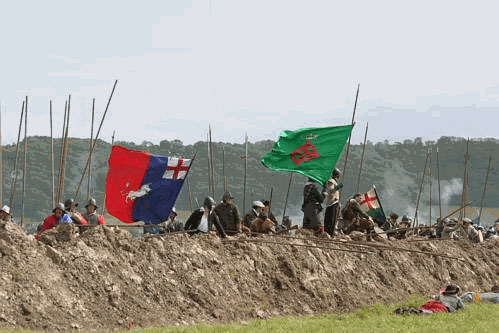
How Will the Stuart Period be Represented at the 7 Ages of Manchester?
The Sealed Knot, represented by Manus O'Cahans Regiment, will be bringing the period to life by representing soldiers and civilians from the period in the Siege of Manchester by Royalist forces in September 1642. We will be dressed in costume from the period as would have been worn by all classes and we will be equipped with weapons and other materials.
During the day we will be able to talk to the public about the Civil Wars and its effect on the country and its people, espcially in the Manchester area. We will also be doing two drill displays each day with firing musketry simulating an infantry company in action.
Where Can I Find Out More About the Stuart Period?
Sealed Knot
Find more information here,
or alternatively
www.sealedknot.org
Quiz Answers
- King Charles 1st
- Parliament
- He was beheaded, on 30 January 1649
